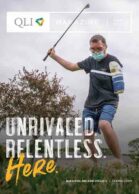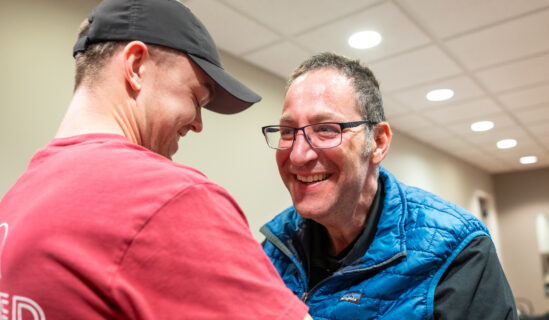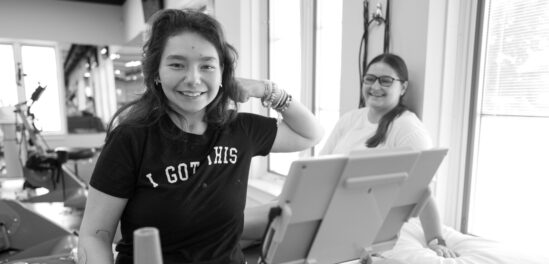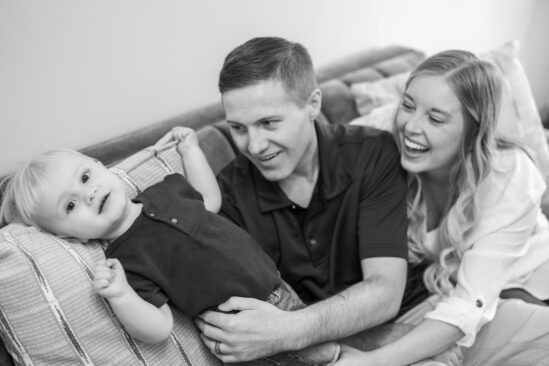The driver picks him up and takes him down the hill. It’s a good day, like many others have been. Once down on QLI’s rehabilitation campus, Andersen Smith heads to the housekeeping office where he gathers his cart filled with cleaning supplies.
He practically bounds into each room with a “hell-oo,” moving with purpose, with the attitude of hard work that fulfills him. He’s a constant of sorts, going room to room in the Colladay Center, changing trash liners, cleaning restrooms. These days not only provide him with confidence but build up his conversational abilities and true friendships.
liners, cleaning restrooms. These days not only provide him with confidence but build up his conversational abilities and true friendships.
__
“I was in the backseat of a car with some friends,” says Andersen. “We went over the median and crashed.” He chuckles wryly. “Wear your seatbelts.” When Andersen’s injury occurred, he was fresh out of high school, still determining what he wanted to do with his life. Though some encouraged him to pursue college, that wasn’t in the cards. In many respects, it seemed impossible for Andersen to go under pretenses and pursue something that would always play second or third fiddle to his true passions—music and fashion.
Like many who take to making a musical name for themselves, Andersen started by mixing CDs, in the days before the dominance of sites like SoundCloud. “My first name was ‘In Time,’” he recalls. “I thought ‘I’m coming, but not yet—just in time.’ But,” he jokes, “if I ever win a Grammy I’m good.” This, combined with his acute sense of style prepared for a future of creativity. But Andersen is certainly a realist, knowing that some income is necessary to dedicate himself to his ultimate goal. His injury did slow the process, though, yet through the remarkable progress he made during his inpatient program at QLI, the drive was still there. It has been difficult, Andersen admits, to reconcile the obstacles that come with a traumatic brain injury, when he wants to throw himself into work–getting a steady income and building himself up for greater passions.
Andersen was one of the clients featured in a brief story in the 2018 issue of the QLI Magazine. It’s clear in the text of his magazine story that he’s ready and excited for the future, expressing his passions for music and fashion, he’s coming into his own.
“I was very hopeful about where my life would go,” says Andersen. “I was ready to get back to working on a steady schedule, earning money, and living as independently as possible.”
 Some time after Andersen was discharged back home, a myriad of complicated circumstances led to him ending up at a local homeless shelter. Despite being a low point, it paved the way for an opportunity.
Some time after Andersen was discharged back home, a myriad of complicated circumstances led to him ending up at a local homeless shelter. Despite being a low point, it paved the way for an opportunity.
The QLI team got word of Andersen’s situation through a mutual connection and immediately went into action. There was availability in QLI’s Lied Assisted Living apartments—a great environment to reengage Andersen in a community, while at the same time re-establishing important skills and providing him with a level of natural support. “Through collaborative discussion with Andersen from the start, we were able to set up clear goals,” says Director of Assisted Living Heath Mlnarik. “The ideal result for Andersen is to discharge back into community living and to find stable, full-time employment.”
“I started doing housekeeping shifts on rehabilitation campus multiple times a week,” says Andersen. Through the housekeeping role, Andersen gained experience in his two key goals: consistent work experience and social skills. The technical responsibilities of the role teach him to keep a schedule, have accountability and other key vocational skills. Interactions with QLI team members, families, and other clients offered invaluable experience with fostering positive relationships.
“While Andersen desires fast change, we’ve worked to make sure he concentrates on each step at a time—checking emails, looking for missed calls, and utilizing many resources,” says vocational specialist Nick Whitver. Nick also helped Andersen connect with Nebraska VR (Vocational Rehabilitation), a state-run employment program aiding those with injuries or disabilities. Andersen reworked his resume and set weekly job-hunting goals. Part of succeeding with independent living is not only having the ability and desire to work but just as important is the ability to self-manage all the components that go into obtaining a job—scheduling, communication with prospective employers, and preparing documentation for orientation processes.
Patience is the greatest tool for Andersen and his team to help him elongate the process, moving thoughtfully and purposefully through the process of applying for jobs and increasing his work hours. Go in too fast, or without the right support behind him, it may be too easy to get overwhelmed or not make solid, healthy decisions. “A full-time job is possible and real for Andersen,” notes Nick. “It is by necessity a slow process. First, it’s about getting a job with a supportive organization. Then, a matter of working part-time steadily, before considering a transition over to full-time.”
“Andersen is young and full of hope,” says Heath, “and we want him to fully realize his dreams.” Being on his own and able to support himself, and having a strong social environment are all key to what Andersen wants.
In the meantime Andersen will keep on keeping on, seeing where the routes of job interviews and opportunities take him, knowing that it is all part of the process of living life on his own terms. “I can still keep my childhood dreams alive,” says Andersen, “and I have a focused path to get there.”













